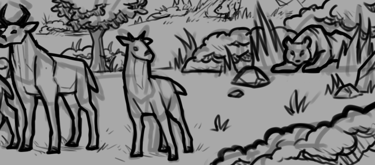

Chapter 3.2 Wildlife Creatures
Creatures
Creature is a term for all animals and material beings (golems) that have different behaviors than monsters. They spawn from resource clusters when a deity is active, and during timed replenishment cycle. Resource clusters will grow a shard that will fall and shatter. A magic burst will occur, and from it, will spawn an animal fully grown. (There are no current plants to have young animals.) Creatures move in patterns based on clusters, and different species will have different effects on clusters.
Ways to Hunt Creatures
Use traps that ensnare, harm, or cage them
Use weapons to attack and defeat them
Loot a hunted or found corpse
Lure using seemingly peaceful means
Tame, ranch, and butcher animals as needed
Creature Behavior
Creatures will have action timers and cooldowns, that allow them to help spread resources, collect them, alter resources, They can also magically duplicate themselves, or magically multiply with other encountered animals. They will also wander and search for new areas, or rest at clusters depending on how their needs (based on timers). Most creatures will be able to assign a base cluster that they will return to and rest if not frequently disturbed or too close to land claims or monster nests. Base clusters in animal/creature groups are decided by the leader. Animals will persist until hunted, or they cannot find a cluster to meet their needs after a long time.
Creature Behavior - Duplication
Group creatures (herds/packs,) can duplicate in a cycle, with a low chance of gaining a new random pattern. Domestication allows for duplication, or breeding for specific patterns. (Patterns covered in detail in a future chapter.)
Creature Behavior - Same species encounters
If encountering the same type of creature, and room in the herd/pack is available, (and not older than the current leader,) they will be added to the group. Otherwise, the animals will either greet and continue walking, or flee, or attack each other. For some species, the creature with more stats will gain the other's followers after a victory.
Creature Behavior - Different species encounters
If creatures of different types encounter, groups, they respond to each other in various reactivity radius sizes. Predators have larger radiuses, that allow them to stalk, or chase after selecting a target animal from a distance. Prey will then respond with running, or defensive maneuvers once the predator reaches their reaction radius.
Creature Avoidance Behavior
Some creatures will avoid claimed land, and constructions in the wild that don't have camouflaging features. Others will be attracted to them, such as rats, raccoons, and bears. Creatures will not be able to select a base cluster near uncamouflaged player and NPC construction.
Creature Inventory
Creatures will not drop gold, but players can collect their resources, inside and out. When creatures eat resources or other animals/monsters/NPC, they will collect these resources in their inventory (ex: stomach). After a certain amount of time these resources will disappear, or change into another resource before starting the disappearing timer. Some items are uniquely connected to certain creatures, with some of them combining with their bodies. If creatures were to kill a player, they will not eat their items, but predators may consume their corpse.
Monster Persistence
Monster will be covered in their own section so briefly, monsters don't appear at world creation. But rather will start to appear depending on existing resources and player action or inaction over time. When monsters appear in the world, they will persist until players or NPC clear them, or they can no longer sustain their needs, and they will die on their own, leaving a corpse that can be harvested. But some may flee to a distant part of the world and persist.
Monster Avoidance Behavior
Wild animals will treat monster nests similarly to player construction, where they will try to avoid it. All animals will not be able to select a base cluster near a monster nest that they are not compatible with. Animals will also react to monsters based on their reactivity radius. Thus, some predator animals higher on the food chain, will attack and eat ads.
Monster Inventory
Will function the same as creature gut inventory, including consumed istructures from attacking player properties, or offerings used to appease them to go away undefeated. They may also contain items found in the wild from NPC or player corpses.
Players seeking nature can choose to bond with it and its deity.
